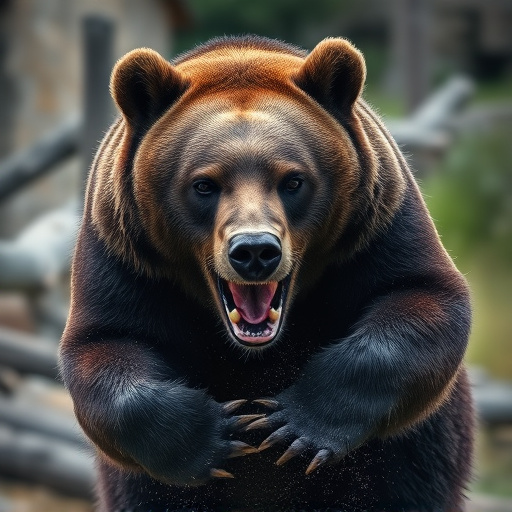Bear spray, a capsaicin-based repellent, is crucial for safety in bear country, with an effective shooting distance of 20-35 feet (6-10 meters). Its range and success are influenced by factors like wind speed and user technique. Optimal deployment involves proper training, licensing, and adherence to local regulations, which vary widely. Staying within the recommended distance ensures both safety and compliance, as bear spray is most effective at close ranges for deterring attacks.
“Unraveling the power of bear spray as a crucial tool for personal safety in wild environments, this article delves into its effectiveness and the factors influencing its range. From understanding the science behind bear spray to mastering its application, we explore what works and what doesn’t.
We’ll dissect key elements that determine the optimal shooting distance for maximum impact, while also shedding light on legal aspects and best practices. Get ready to transform your outdoor experience with this essential knowledge on bear spray’s effective range.”
- Understanding Bear Spray: What It Is and How It Works
- Factors Affecting Bear Spray Range and Effectiveness
- Best Practices for Using Bear Spray in the Wild
- Legal Considerations and Regulations Regarding Bear Spray Use
Understanding Bear Spray: What It Is and How It Works
Bear spray, also known as bear repellent, is a specialized aerosol designed to deter and discourage aggressive behavior from bears, primarily black bears and grizzly bears. It’s a crucial tool for outdoor enthusiasts, hikers, and anyone navigating bear country. The effectiveness of bear spray lies in its ability to create a barrier between the user and the bear by releasing a powerful scent that is unpleasant to bears.
This potent spray contains capsaicin, the active ingredient found in chili peppers, mixed with other odor-enhancing chemicals. When sprayed, it creates a thick cloud that can reach an effective shooting distance range of up to 20 feet (6 meters). This range allows users to create a safe space and deter bears from approaching, providing valuable time for retreat or de-escalation. The spray’s effectiveness is not just about the force of the spray but also the chemical composition that triggers a bear’s natural aversion to the scent, ensuring it remains a reliable deterrent in various outdoor scenarios.
Factors Affecting Bear Spray Range and Effectiveness
The effectiveness and range of bear spray as a deterrent are influenced by several key factors. One major consideration is the user’s shooting distance—the closer the spray can be deployed, the greater its impact. Bear spray is most effective when used at close to medium ranges, typically between 20 to 100 feet (6 to 30 meters). Beyond this range, the fine mist of pepper spray may not fully cover the bear or may dissipate enough to reduce its effectiveness.
Another critical factor is wind direction and speed. Tailwinds can carry the spray away from the target, while headwinds might blow it directly at the bear, enhancing its impact. Additionally, environmental conditions such as temperature, humidity, and terrain play a role in determining how far and effectively the spray will reach. These variables underscore the importance of proper training for users, ensuring they understand the optimal deployment techniques to maximize the bear spray’s effective shooting distance range.
Best Practices for Using Bear Spray in the Wild
When it comes to bear spray, understanding its effective shooting distance range is crucial for safety in wild environments. The optimal range varies between 20-35 feet (6-10 meters), but factors like wind, terrain, and sprayer technique can influence this. It’s essential to follow best practices for optimal use: ensure the canister is properly licensed and compliant with local regulations, check expiration dates regularly, and familiarize yourself with the sprayer’s mechanism before deployment.
At close range, bear spray can be a highly effective deterrent, creating a temporary blind spot for bears by irritating their eyes and respiratory system. However, using it beyond the recommended range may result in inefficient coverage or even harm to nearby individuals or wildlife. Practice responsible use, stay calm under pressure, and always consult with local parks officials for specific guidelines regarding bear spray deployment in various ecosystems.
Legal Considerations and Regulations Regarding Bear Spray Use
The use of bear spray is regulated by local, state, and federal laws, with regulations varying across different regions. Before carrying bear spray, it’s crucial to understand the legal considerations and restrictions in your area. Many jurisdictions require permits or licenses for possession, and there might be specific guidelines on where and when it can be used. For instance, some areas limit its use to certain seasons or locations, such as wilderness parks or grizzly bear habitats.
In terms of effective shooting distance range, bear spray is designed to deter bears from attacking at close ranges, typically between 20 to 30 feet (6 to 9 meters). Beyond this range, the spray may not have a significant effect, and the bear could still charge. It’s important for users to be within this recommended distance to ensure the spray works as intended and complies with local regulations regarding its use.
Bear spray is an effective deterrent, but its range varies based on several factors. Understanding these variables and adhering to best practices can ensure its success in repelling bears. Always consult local regulations and use bear spray responsibly while enjoying the outdoors. By following these guidelines, you can enhance your safety and minimize potential conflicts with these majestic animals.
